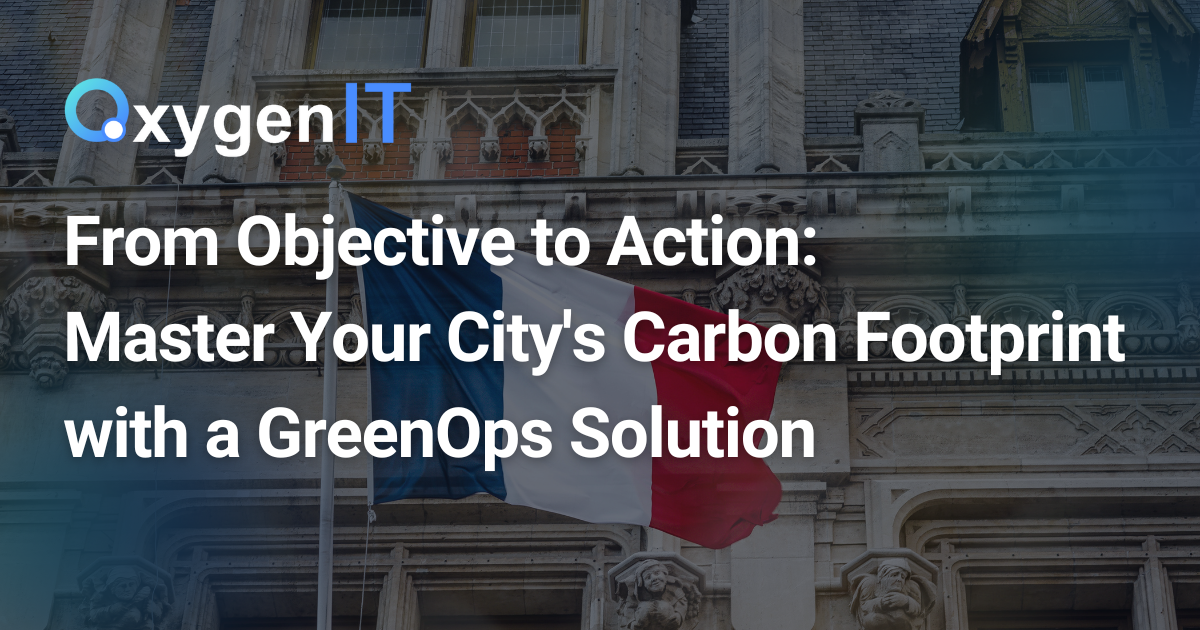OxygenIT remporte le prix API 2025 pour la meilleure observabilité des API
Découvrez comment GreenOps et FinOps peuvent collaborer pour parvenir à une solution gagnant-gagnant en matière de durabilité et d'optimisation budgétaire.

In today's digital landscape, the IT sector contributes significantly to the global carbon footprint as it accounts for roughly 2.8% of global greenhouse gas emissions, and this number is projected to rise. In addition, cloud workload alone is responsible for 1% of global electricity consumption, forecasted to reach 5% by 2030.
Based on a study by McKinsey & Company, within a narrow context of an enterprise, carbon emissions from IT-related components like data centers, cloud computing, IT services, and software constitute approximately 52.5% of the overall carbon emissions.

The need to address this environmental impact while simultaneously optimizing costs creates a complex challenge for businesses, and it is continuously growing, as described in IDC’s 2023 survey. In this survey, sustainability (37%) and FinOps (31%) are the top two areas that organizations have identified for investment to optimize their cloud operations. Fortunately, the two distinct yet complementary approaches, GreenOps and FinOps, together offer a unified solution.
GreenOps focuses on implementing sustainable practices within IT infrastructure and operations. This includes optimizing resource utilization, minimizing energy consumption, and promoting the use of eco-friendly technologies. FinOps, on the other hand, emphasizes financial accountability and cost optimization for cloud and IT resources.
While operating independently, these two disciplines share a critical synergy: reduced resource utilization translates to both lower costs and minimized environmental impact. Let's delve deeper into how GreenOps and FinOps can collaborate to achieve a win-win for sustainability and budget optimization.
Cloud Cost Savings: Reducing idle servers, optimizing workloads, and utilizing energy-efficient technologies through GreenOps directly translates to lower operational costs. FinOps practices like right-sizing resources and implementing pay-as-you-go models further amplify these savings.
Improved Cloud Resource Utilization: Both GreenOps and FinOps promote efficient cloud resource usage. GreenOps focuses on minimizing wasted compute power and storage, while FinOps encourages eliminating over-provisioning and underutilized resources. This collaborative approach maximizes both financial and environmental efficiency.
Enhanced Business Continuity: GreenOps practices like regular backups and disaster recovery planning improve resilience against disruptions, ultimately reducing downtime and associated costs. Similarly, FinOps principles like proactive monitoring and cost forecasting contribute to greater financial stability, protecting against unexpected outages.
Data Center Optimization: Both approaches encourage efficient data center operations. GreenOps focuses on energy-efficient cooling systems and renewable energy sources, while FinOps promotes optimizing data center utilization to reduce idle resources and associated costs.
Transparency and Accountability: Both GreenOps and FinOps emphasize transparency in resource consumption and cost allocation transparency. This encourages informed decision-making and promotes responsible IT practices within organizations.
Traditionally, GreenOps and FinOps focused on distinct goals: sustainability for the former and cost optimization for the latter. However, their objectives revolve around resource utilization - less usage translates to lower costs and reduced environmental impact. Here are some actionable steps for adopting GreenOps and FinOps:
Start with an Assessment: Measure and evaluate your current IT infrastructure and practices. Identify areas where you can improve resource utilization, reduce energy consumption, and eliminate unnecessary costs.
Set Measurable Goals: Define clear and measurable goals for both GreenOps and FinOps. This could involve targets for carbon footprint reduction, cost savings, or improvements in resource efficiency.
Build Cross-Functional Teams: Establish collaborative teams comprising GreenOps and FinOps specialists. This fosters communication and ensures both perspectives are considered when making decisions. Implicate IT personnel, incite IT teams to be proactive, and integrate carbon emissions and cost control into their IT operational decision-making.
Leverage Technology Tools: Consider solutions like OxygenIT. This tool empowers you to measure, monitor, and optimize your IT infrastructure's carbon footprint in a very short amount of time. It provides granular insights into energy consumption and emissions, enabling informed decision-making for both GreenOps and FinOps teams.
Track Progress and Adapt: Regularly monitor your progress against your set goals. Use data from OxygenIT and other tools to identify areas for improvement and adapt your strategy accordingly.
OxygenIT is a solution that empowers businesses to measure, monitor, and optimize their IT infrastructure's carbon footprint. It offers granular insights into energy consumption and emissions, enabling informed decision-making for GreenOps and FinOps teams.
Here's how OxygenIT facilitates collaboration:
Transparency: By providing comprehensive and precise data, OxygenIT fosters transparency across both sides, allowing for informed decisions based on both cost and environmental impact.
Optimization: OxygenIT pinpoints areas of high energy consumption and high carbon emissions, aligning with GreenOps' sustainability goals and FinOps' cost-reduction objectives.
Infrastructure simulations: OxygenIT allows IT teams to simulate possible IT infrastructure scenarios and changes. Teams can compare and contrast without limit, and then choose the best scenario to meet their objectives.
Progress Tracking: Real-time data on carbon footprint reduction and cost savings enables both teams to monitor progress and measure the effectiveness of their initiatives.
Streamlined Collaboration: OxygenIT acts as a common platform, facilitating data sharing and collaboration between GreenOps and FinOps, ensuring alignment towards shared sustainability and cost optimization goals.
The combined power of GreenOps, FinOps, and tools like OxygenIT paves the way for a future where cloud operations are both cost-effective and environmentally responsible. By leveraging these solutions, businesses can:
By bridging the gap between GreenOps and FinOps, OxygenIT plays a crucial role in this journey toward a more sustainable future for cloud computing.
.png)


Commencez dès aujourd'hui
Des données précises et vérifiables sur le carbone pour optimiser les FinOps, les rapports ESG et les choix IT durables.
Conçu pour toutes les équipes. Prêt pour n'importe quel stack.